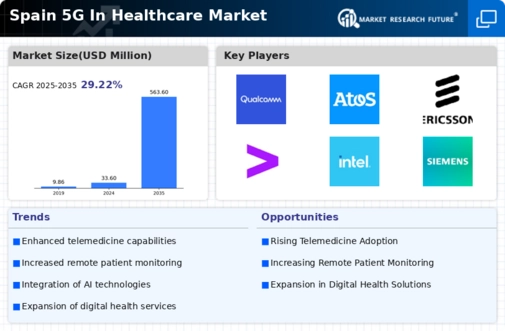The Spain 5G in Healthcare Market is characterized by rapid technological advancements and increasing adoption of digital health solutions, leading to unprecedented levels of competition among key stakeholders in the sector. As the healthcare industry seeks to improve patient care and operational efficiency through innovative technologies, the integration of 5G networks is becoming essential.
The competitive landscape includes traditional telecom operators, technology firms, and specialized healthcare service providers, all vying for a significant share of the growing market. Companies are focusing on establishing partnerships and collaborations to enhance their service offerings and leverage 5G's capabilities to deliver real-time data processing, remote monitoring, and telemedicine services that meet the evolving needs of patients and healthcare professionals in Spain.
Qualcomm, a leading technology company, has made significant strides in driving the adoption of 5G technology within the Spanish healthcare market. The company’s extensive portfolio includes advanced chipsets and software solutions designed to enable high-speed connectivity essential for the deployment of telehealth systems and smart medical devices. Qualcomm's strengths lie in its ability to facilitate seamless communication across healthcare networks, enhance remote patient monitoring, and provide robust security features, thereby ensuring data protection and privacy in healthcare transactions.
With a strong presence in Spain, Qualcomm has collaborated with various healthcare institutions and technology partners, successfully integrating 5G technology into medical applications and contributing to better patient outcomes and operational efficiencies.
Atos is another key player in the Spain 5G in Healthcare Market, known for its comprehensive digital services and solutions aimed at the healthcare sector. The company offers a range of key products and services, including cloud solutions, data analytics, and cybersecurity, to support healthcare institutions in optimizing their operations and improving healthcare delivery. Atos has established a notable presence in the Spanish market through partnerships with hospitals and healthcare providers, enabling the implementation of advanced 5G applications for telemedicine, patient management systems, and connected devices.
The company's strengths lie in its industry expertise and innovative solutions that address the specific needs of the healthcare sector. Furthermore, Atos has been proactive in pursuing strategic mergers and acquisitions in Spain, enhancing its capabilities and expanding its footprint in the 5G healthcare landscape, thus positioning itself to make impactful contributions to the sector.















